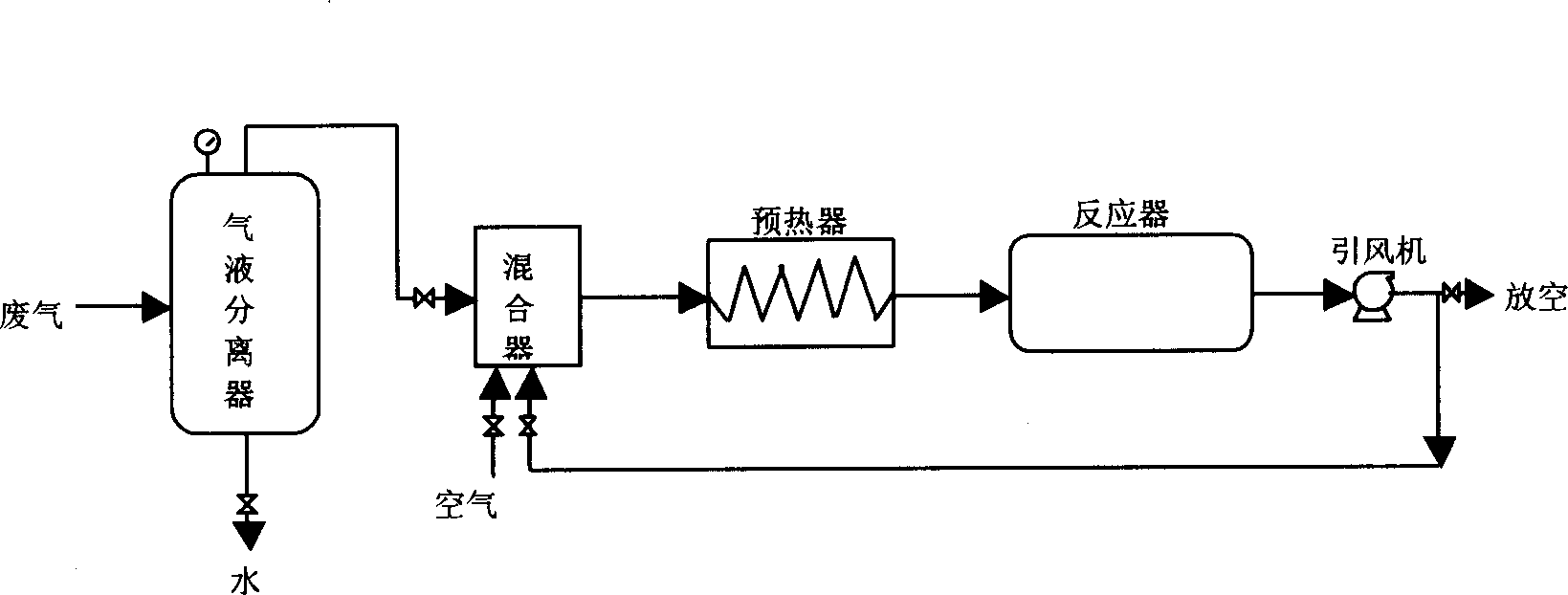Waste polyester gas purification
A waste gas, polyester technology, applied in chemical instruments and methods, combustion methods, separation methods, etc., can solve the problems of people's health hazards, affecting the quality of the atmospheric environment in the factory area, and high equipment costs, reducing equipment investment and operating costs, Good economic and environmental benefits, high heat recovery efficiency
- Summary
- Abstract
- Description
- Claims
- Application Information
AI Technical Summary
Problems solved by technology
Method used
Image
Examples
Embodiment 1
[0019] The honeycomb monolithic block catalyst loaded with precious metals is used. After passing through the gas-liquid separator, the exhaust gas is diluted with air to acetaldehyde content of 3766.4mg / m3 3 , 2-methyl-1,3-dioxolane 3854.7mg / m 3 , the reactor inlet temperature is 245°C, and the bed gas phase space velocity is 20000h -1 Under the conditions of the reaction tail gas, acetaldehyde and 2-methyl-1,3-dioxolane have been completely converted, and the concentration of non-methane total hydrocarbons in the tail gas is 0 mg / m 3 .
Embodiment 2
[0021] The honeycomb monolithic block catalyst loaded with precious metals is used. After the exhaust gas passes through the gas-liquid separator, it is diluted with air and part of the reaction tail gas to the acetaldehyde content of the mixed gas 4833.3mg / m3 3 , 2-methyl-1,3-dioxolane 5203.8mg / m 3 , the reactor inlet temperature is 245°C, and the gas phase space velocity of the bed is 25000h -1 Under the conditions, the acetaldehyde in the reaction tail gas has been completely converted, and the 2-methyl-1,3-dioxolane is 12.87mg / m 3 , the total non-methane hydrocarbon concentration is 16.02mg / m 3 .
Embodiment 3
[0023] The honeycomb monolithic block catalyst loaded with precious metals is used. After the exhaust gas passes through the gas-liquid separator, it is diluted with air and part of the reaction tail gas to contain acetaldehyde 5741.86mg / m in the mixed gas. 3 , 2-methyl-1,3-dioxolane 5547.95mg / m 3 , the reactor inlet temperature is 230°C, and the bed gas phase space velocity is 27000h -1 Under the conditions of the reaction tail gas, acetaldehyde and 2-methyl-1,3-dioxolane have been completely converted, and the concentration of non-methane total hydrocarbons is 0 mg / m 3 .
PUM
 Login to View More
Login to View More Abstract
Description
Claims
Application Information
 Login to View More
Login to View More - R&D
- Intellectual Property
- Life Sciences
- Materials
- Tech Scout
- Unparalleled Data Quality
- Higher Quality Content
- 60% Fewer Hallucinations
Browse by: Latest US Patents, China's latest patents, Technical Efficacy Thesaurus, Application Domain, Technology Topic, Popular Technical Reports.
© 2025 PatSnap. All rights reserved.Legal|Privacy policy|Modern Slavery Act Transparency Statement|Sitemap|About US| Contact US: help@patsnap.com

